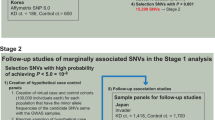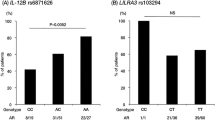Abstract
Kawasaki disease is a pediatric systemic vasculitis of unknown etiology for which a genetic influence is suspected. We identified a functional SNP (itpkc_3) in the inositol 1,4,5-trisphosphate 3-kinase C (ITPKC) gene on chromosome 19q13.2 that is significantly associated with Kawasaki disease susceptibility and also with an increased risk of coronary artery lesions in both Japanese and US children. Transfection experiments showed that the C allele of itpkc_3 reduces splicing efficiency of the ITPKC mRNA. ITPKC acts as a negative regulator of T-cell activation through the Ca2+/NFAT signaling pathway, and the C allele may contribute to immune hyper-reactivity in Kawasaki disease. This finding provides new insights into the mechanisms of immune activation in Kawasaki disease and emphasizes the importance of activated T cells in the pathogenesis of this vasculitis.
This is a preview of subscription content, access via your institution
Access options
Subscribe to this journal
Receive 12 print issues and online access
$209.00 per year
only $17.42 per issue
Buy this article
- Purchase on Springer Link
- Instant access to full article PDF
Prices may be subject to local taxes which are calculated during checkout





Similar content being viewed by others
Accession codes
References
Kawasaki, T. Acute febrile mucocutaneous syndrome with lymphoid involvement with specific desquamation of the fingers and toes: my clinical observation (in Japanese). Jpn. J. Allergy 16, 178–222 (1967). English translation by Shike, H., Burns, J.C. & Shimizu, C. Pediatr. Infect. Dis. J. 21, 993–995 (2002).
Kato, H., Koike, S., Yamamoto, M., Ito, Y. & Yano, E. Coronary aneurysms in infants and young children with acute febrile mucocutaneous lymph node syndrome. J. Pediatr. 86, 892–898 (1975).
Kato, H. et al. Long-term consequences of Kawasaki disease. A 10- to 21-year follow-up study of 594 patients. Circulation 94, 1379–1385 (1996).
Cook, D.H. et al. Results from an international survey of Kawasaki disease in 1979–82. Can. J. Cardiol. 5, 389–394 (1989).
Fujita, Y. et al. Kawasaki disease in families. Pediatrics 84, 666–669 (1989).
Uehara, R., Yashiro, M., Nakamura, Y. & Yanagawa, H. Kawasaki disease in parents and children. Acta Paediatr. 92, 694–697 (2003).
Dergun, M. et al. Familial occurrence of Kawasaki syndrome in North America. Arch. Pediatr. Adolesc. Med. 159, 876–881 (2005).
Onouchi, Y. et al. A genome-wide linkage analysis for Kawasaki disease: evidence for linkage to chromosome 12. J. Hum. Genet. 52, 179–190 (2007).
Imboden, J.B. & Pattison, G. Regulation of inositol 1,4,5-trisphosphate kinase activity after stimulation of human T cell antigen receptor. J. Clin. Invest. 79, 1538–1541 (1987).
Dewaste, V. et al. Cloning and expression of a cDNA encoding human inositol 1,4,5-trisphosphate 3-kinase C. Biochem. J. 352, 343–351 (2000).
Berridge, M.J. & Irvine, R.F. Inositol trisphosphate, a novel second messenger in cellular signal transduction. Nature 312, 315–321 (1984).
Harnick, D.J. et al. The human type 1 inositol 1,4,5-trisphosphate receptor from T lymphocytes. Structure, localization, and tyrosine phosphorylation. J. Biol. Chem. 270, 2833–2840 (1995).
Weiss, A. & Littman, D.R. Signal transduction by lymphocyte antigen receptors. Cell 76, 263–274 (1994).
Macian, F. NFAT proteins: key regulators of T-cell development and function. Nat. Rev. Immunol. 5, 472–484 (2005).
Cogan, J.D. et al. A novel mechanism of aberrant pre-mRNA splicing in humans. Hum. Mol. Genet. 6, 909–912 (1997).
von Ahsen, N. & Oellerich, M. The intronic prothrombin 19911A>G polymorphism influences splicing efficiency and modulates effects of the 20210G>A polymorphism on mRNA amount and expression in a stable reporter gene assay system. Blood 103, 586–593 (2004).
Morisaki, H., Morisaki, T., Newby, L.K. & Holmes, E.W. Alternative splicing: a mechanism for phenotypic rescue of a common inherited defect. J. Clin. Invest. 91, 2275–2280 (1993).
Krawczak, M. et al. Single base-pair substitutions in exon-intron junctions of human genes: nature, distribution, and consequences for mRNA splicing. Hum. Mutat. 28, 150–158 (2007).
Krawczak, M., Reiss, J. & Cooper, D.N. The mutational spectrum of single base-pair substitutions in mRNA splice junctions of human genes: causes and consequences. Hum. Genet. 90, 41–54 (1992).
Majewski, J. & Ott, J. Distribution and characterization of regulatory elements in the human genome. Genome Res. 12, 1827–1836 (2002).
Yeo, G., Hoon, S., Venkatesh, B. & Burge, C.B. Variation in sequence and organization of splicing regulatory elements in vertebrate genes. Proc. Natl. Acad. Sci. USA 101, 15700–15705 (2004).
Louie, E., Ott, J. & Majewski, J. Nucleotide frequency variation across human genes. Genome Res. 13, 2594–2601 (2003).
McCullough, A.J. & Berget, S.M. G triplets located throughout a class of small vertebrate introns enforce intron borders and regulate splice site selection. Mol. Cell. Biol. 17, 4562–4571 (1997).
Buratti, E. & Baralle, F.E. Influence of RNA secondary structure on the pre-mRNA splicing process. Mol. Cell. Biol. 24, 10505–10514 (2004).
Varani, L. et al. Structure of tau exon 10 splicing regulatory element RNA and destabilization by mutations of frontotemporal dementia and parkinsonism linked to chromosome 17. Proc. Natl. Acad. Sci. USA 96, 8229–8234 (1999).
Yoshioka, T. et al. Polyclonal expansion of TCRBV2- and TCRBV6-bearing T cells in patients with Kawasaki disease. Immunology 96, 465–472 (1999).
Brown, T.J. et al. CD8 T lymphocytes and macrophages infiltrate coronary artery aneurysms in acute Kawasaki disease. J. Infect. Dis. 184, 940–943 (2001).
Fukunishi, M. et al. Prediction of non-responsiveness to intravenous high-dose gamma-globulin therapy in patients with Kawasaki disease at onset. J. Pediatr. 137, 172–176 (2000).
Egami, K. et al. Prediction of resistance to intravenous immunoglobulin treatment in patients with Kawasaki disease. J. Pediatr. 149, 237–240 (2006).
Sano, T. et al. Prediction of non-responsiveness to standard high-dose gamma-globulin therapy in patients with acute Kawasaki disease before starting initial treatment. Eur. J. Pediatr. 166, 131–137 (2007).
Kobayashi, T. et al. Prediction of intravenous immunoglobulin unresponsiveness in patients with Kawasaki disease. Circulation 113, 2606–2612 (2006).
Ho, S. et al. The mechanism of action of cyclosporin A and FK506. Clin. Immunol. Immunopathol. 80, S40–S45 (1996).
Raman, V., Kim, J., Sharkey, A. & Chatila, T. Response of refractory Kawasaki disease to pulse steroid and cyclosporin A therapy. Pediatr. Infect. Dis. J. 20, 635–637 (2001).
Lewis, R. Calcium signaling mechanisms in T lymphocytes. Annu. Rev. Immunol. 19, 497–521 (2001).
Ayusawa, M. et al. Revision of diagnostic guidelines for Kawasaki disease (the 5th revised edition). Pediatr. Int. 47, 232–234 (2005).
Burns, J.C. et al. Family-based association analysis implicates IL-4 in susceptibility to Kawasaki disease. Genes Immun. 6, 438–444 (2005).
Suzuki, A. et al. Functional haplotypes of PADI4, encoding citrullinating enzyme peptidylarginine deiminase 4, are associated with rheumatoid arthritis. Nat. Genet. 34, 395–402 (2003).
Spielman, R.S., McGinnis, R.E. & Ewens, W.J. Transmission test for linkage disequilibrium: the insulin gene region and insulin-dependent diabetes mellitus (IDDM). Am. J. Hum. Genet. 52, 506–516 (1993).
Kazeem, G.R. & Farrall, M. Integrating case-control and TDT studies. Ann. Hum. Genet. 69, 329–335 (2005).
Uejima, H., Lee, M.P., Cui, H. & Feinberg, A.P. Hot-stop PCR: a simple and general assay for linear quantitation of allele ratios. Nat. Genet. 25, 375–376 (2000).
Acknowledgements
We thank the individuals with Kawasaki disease and their families who participated in this project. We are grateful to H. Aotsuka, H. Nakajima, F. Kudo, M. Miura, K. Akagi, T. Matsubara, M. Nishibatake, S. Oku, K. Sameshima, Y. Tanaka, Y. Nomura, S. Ogita, M. Sakauchi, T. Isobe, T. Sano, T. Matsushita and other physicians who contributed DNA samples. We thank J. Pancheri and A. Baker for collection of DNA samples and D. Scherrer, H. Sugiyama and M. Saito for technical assistance. This work was supported by grants from the Japanese Millennium Project, from the Japan Society for the Promotion of Science (16591069 to Y.O.) and from the National Heart, Lung, Blood Institute of the National Institutes of Health (HL69413 to J.C.B.).
Author information
Authors and Affiliations
Contributions
Y.O., A.H. and Yusuke N. designed the study. Y.O., J.C.B., C.S., J.W.N., F.K., K.H., M.T., Y.S., K.O., T.S., A.N., Y.K., T.Y., K.S., Takeo T., T.N., H.C. and A.F. collected most of the samples. M.Y., Yoshikazu N., H.Y. and T.K. provided information regarding the Japanese nation-wide survey of Kawasaki disease. K.W. and Y.F. established lymphoblastoid cell lines of individuals with Kawasaki disease. Tatsuhiko T. and A.S. supported the initial SNP screening by providing genotyping data for the control population. Y.O. performed genotyping and statistical analyses. R.N. and Tatsuhiko T. performed logistic regression analyses. Y.O. and T.G. performed functional assays. Y.O., J.C.B., C.S., J.W.N. and A.H. wrote the paper.
Corresponding author
Supplementary information
Supplementary Text and Figures
Supplementary Figures 1–4, Supplementary Tables 1–3, Supplementary Methods (PDF 3090 kb)
Rights and permissions
About this article
Cite this article
Onouchi, Y., Gunji, T., Burns, J. et al. ITPKC functional polymorphism associated with Kawasaki disease susceptibility and formation of coronary artery aneurysms. Nat Genet 40, 35–42 (2008). https://doi.org/10.1038/ng.2007.59
Received:
Accepted:
Published:
Issue Date:
DOI: https://doi.org/10.1038/ng.2007.59
This article is cited by
-
Origin, evolution, and diversification of inositol 1,4,5-trisphosphate 3-kinases in plants and animals
BMC Genomics (2024)
-
Viral load of Torquetenovirus correlates with Sano’s score and levels of total bilirubin and aspartate aminotransferase in Kawasaki disease
Scientific Reports (2023)
-
Association of Genetic Polymorphisms in Kawasaki Disease with the Response to Intravenous Immunoglobulin Therapy
Pediatric Cardiology (2023)
-
Whole-Exome Sequencing for Identification of Potential Sex-Biased Variants in Kawasaki Disease Patients
Inflammation (2023)
-
Inositol-Triphosphate 3-Kinase C and DNA Methylation Involvement in NLRP3 Inflammasome Activation in Kawasaki Disease
Indian Journal of Pediatrics (2023)



